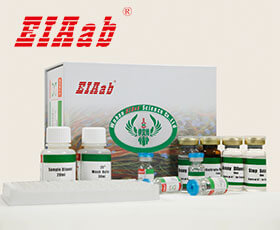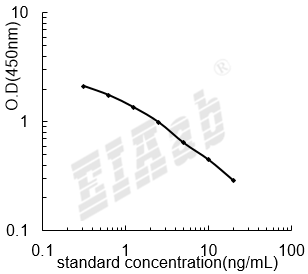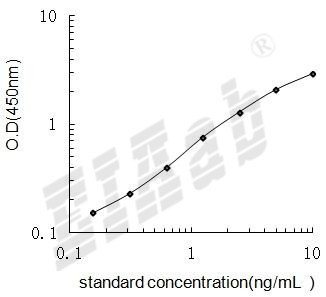KCNB1 (基因名), Potassium voltage-gated channel subfamily B member 1 (蛋白名), kcnb1_pig.
产品名称:
Pig KCNB1/ Potassium voltage-gated channel subfamily B member 1 Recombinant Protein
货号:
-
商标:
EIAab®
监管等级:
别名:
Delayed rectifier potassium channel 1, Voltage-gated potassium channel subunit Kv2.1, DRK1
序列号:
O18868
来源:
E.coli
种属:
Pig
标签:
His
纯度:
>90% by SDS-PAGE
浓度:
Reconstitution Dependent
形态:
Liquid
内毒素水平:
Please contact protein@eiaab.com The technician for more information.
应用:
存储缓冲液:
50mM NaH2PO4, 500mM NaCl Buffer with 500mM Imidazole, 10%glycerol(PH8.0)
存储:
Store at -20°C. (Avoid repeated freezing and thawing.)
研究领域:
-
通用注释
亚单元:
Homotetramer or heterotetramer with KCNB2. Heterotetramer with non-conducting channel-forming alpha subunits such as KCNF1, KCNG1, KCNG3, KCNG4, KCNH1, KCNH2, KCNS1, KCNS2, KCNS3 and KCNV1. Channel activity is regulated by association with ancillary beta subunits such as AMIGO1, KCNE1, KCNE2 and KCNE3. Self-associates (via N-terminus and C-terminus); self-association is required to regulate trafficking, gating and C-terminal phosphorylation-dependent modulation of the channel. Interacts (via C-terminus) with STX1A (via C-terminus); this decreases the rate of channel activation and increases the rate of channel inactivation in pancreatic beta cells, induces also neuronal apoptosis in response to oxidative injury as well as pore-independent enhancement of exocytosis in neuroendocrine cells, chromaffin cells, pancreatic beta cells and from the soma of dorsal root ganglia (DRG) neurons. Interacts (via N-terminus) with SNAP25; this decreases the rate of channel inactivation in pancreatic beta cells and also increases interaction during neuronal apoptosis in a N-methyl-D-aspartate receptor (NMDAR)-dependent manner. Interacts (via N-terminus and C-terminus) with VAMP2 (via N-terminus); stimulates channel inactivation rate. Interacts with CREB1; this promotes channel acetylation in response to stimulation by incretin hormones. Interacts (via N-terminus and C-terminus) with MYL12B. Interacts (via N-terminus) with PIAS3; this increases the number of functional channels at the cell surface. Interacts with SUMO1. Interacts (via phosphorylated form) with PTPRE; this reduces phosphorylation and channel activity in heterologous cells.
功能:
Voltage-gated potassium channel that mediates transmembrane potassium transport in excitable membranes, primarily in the brain, but also in the pancreas and cardiovascular system. Contributes to the regulation of the action potential (AP) repolarization, duration and frequency of repetitive AP firing in neurons, muscle cells and endocrine cells and plays a role in homeostatic attenuation of electrical excitability throughout the brain. Plays also a role in the regulation of exocytosis independently of its electrical function. Forms tetrameric potassium-selective channels through which potassium ions pass in accordance with their electrochemical gradient. The channel alternates between opened and closed conformations in response to the voltage difference across the membrane. Homotetrameric channels mediate a delayed-rectifier voltage-dependent outward potassium current that display rapid activation and slow inactivation in response to membrane depolarization. Can form functional homotetrameric and heterotetrameric channels that contain variable proportions of KCNB2; channel properties depend on the type of alpha subunits that are part of the channel. Can also form functional heterotetrameric channels with other alpha subunits that are non-conducting when expressed alone, such as KCNF1, KCNG1, KCNG3, KCNG4, KCNH1, KCNH2, KCNS1, KCNS2, KCNS3 and KCNV1, creating a functionally diverse range of channel complexes (By similarity). Heterotetrameric channel activity formed with KCNS3 show increased current amplitude with the threshold for action potential activation shifted towards more negative values in hypoxic-treated pulmonary artery smooth muscle cells. Channel properties are also modulated by cytoplasmic ancillary beta subunits, such as AMIGO1, KCNE1, KCNE2 and KCNE3, slowing activation and inactivation rate of the delayed rectifier potassium channels. In vivo, membranes probably contain a mixture of heteromeric potassium channel complexes, making it difficult to assign currents observed in intact tissues to any particular potassium channel family member. Major contributor to the delayed-rectifier voltage-gated potassium current in neurons of the central nervous system, sympathetic ganglion neurons, neuroendocrine cells, pancreatic beta cells, cardiomyocytes and smooth muscle. Mediates the major part of the somatodendritic delayed-rectifier potassium current in hippocampal and cortical pyramidal neurons and sympathetic superior cervical ganglion (CGC) neurons that acts to slow down periods of firing, especially during high frequency stimulation. Plays a role in the induction of long-term potentiation (LTP) of neuron excitability in the CA3 layer of the hippocampus. Contributes to the regulation of the glucose-induced amplitude and duration of action potentials in pancreatic beta-cells, hence limiting calcium influx and insulin secretion. Plays a role in the regulation of resting membrane potential and contraction in hypoxia-treated pulmonary artery smooth muscle cells. May contribute to the regulation of the duration of both the action potential of cardiomyocytes and the heart ventricular repolarization QT interval. Contributes to the pronounced pro-apoptotic potassium current surge during neuronal apoptotic cell death in response to oxidative injury. May confer neuroprotection in response to hypoxia/ischemic insults by suppressing pyramidal neurons hyperexcitability in hippocampal and cortical regions. Promotes trafficking of KCNG3, KCNH1 and KCNH2 to the cell surface membrane, presumably by forming heterotetrameric channels with these subunits. Plays a role in the calcium-dependent recruitment and release of fusion-competent vesicles from the soma of neurons, neuroendocrine and glucose-induced pancreatic beta cells by binding key components of the fusion machinery in a pore-independent manner.
亚细胞位置:
Cell membrane
Perikaryon
Cell projection
Axon
Cell projection
Dendrite
Membrane
Multi-pass membrane protein
Cell junction
Synapse
Postsynaptic cell membrane
Cell junction
Synapse
Cell junction
Synapse
Synaptosome
Lateral cell membrane
Cell membrane
Sarcolemma
Localizes to high-density somatodendritic clusters and non-clustered sites on the surface of neocortical and hippocampal pyramidal neurons in a cortical actin cytoskeleton-dependent manner. Localizes also to high-density clusters in the axon initial segment (AIS), at ankyrin-G-deficient sites, on the surface of neocortical and hippocampal pyramidal neurons. KCNB1-containing AIS clusters localize either in close apposition to smooth endoplasmic reticulum cisternal organelles or with GABA-A receptor-containing synapses of hippocampal and cortical pyramidal neurons, respectively. Localizes to high-density clusters on the cell surface of atrial and ventricular myocytes and at the lateral plasma membrane in epithelial cells. Localizes both to the axial and transverse tubules (T tubule) and sarcolemma in ventricular myocytes. Associated with lipid raft domains. In cortical neurons, apoptotic injuries induce de novo plasma membrane insertion in a SNARE-dependent manner causing an apoptotic potassium current surge.
数据库链接
UniGene:
SMR:
STRING:
KEGG:
Pfam:
Uniprot:
您可能感兴趣
该产品尚未在任何出版物中被引用。
[1].
猪KCNB1重组蛋白是否是无菌的?
蛋白试剂瓶和蛋白保存液是经过高压灭菌的,但也不能保证蛋白是完全无菌的。如果要求蛋白是无菌的,可以用0.2微米的滤器对蛋白进行过滤。
[2].
猪KCNB1重组蛋白的保存缓冲液是什么?
纯化后的蛋白保存在PBS(58mM Na2HPO4, 17mM NaH2PO4, 68mM NaCl, pH7.4)里,并往里面加入500mM咪唑和10%甘油。
[3].
怎样确定猪KCNB1重组蛋白的浓度?
蛋白浓度的确定没有一个统一的标准,这主要取决于蛋白的氨基酸序列。伊艾博是根据不同测试的组合来测定蛋白浓度。考马斯亮蓝法、BCA法、氨基酸序列和氨基酸全序列分析法等都用来测定蛋白浓度。
[4].
猪KCNB1重组蛋白蛋白保存条件是怎样的?
蛋白应保存在 -20℃或 -80℃条件下,为了避免反复冻融,可以将蛋白分装成小份保存。
[5].
猪KCNB1重组蛋白是否可以用于活体实验?
重组蛋白没有用于任何的活体实验,因此蛋白的活性和半衰期是不确定的。
[6].
猪KCNB1重组蛋白的保质期是多久?
在适当的保存条件下,从购买之日起蛋白可以稳定保存6-12个月。适当的保存条件是:蛋白保存在-20°C o或 -80℃,保证蛋白的保存浓度高于0.1mg/ml,限制蛋白反复冻融的次数。我们公司常规的质量检测保证所有产品在销售时都有可接受的生物活性。但是我们不能控制终端用户蛋白的保存条件。如果产品在有效期内出现问题,请联系我们的技术支持。
[7].
你们蛋白和抗体的报价是怎么样的?
我们将根据你需要的蛋白和抗体的大小进行报价。
[8].
猪KCNB1重组蛋白是否能够提供蛋白片段?
我们现有的人的蛋白的序列可以有很多。你可以选择你感兴趣的靶向部分,我们将会按您的需求提供蛋白和抗体。
[9].
猪KCNB1重组蛋白的货期或发货时间一般是多长?
具体指标的货期需要确定。最快一周,最长可能一个月。
反馈墙
评论数 : 0
所有用户
所有用户
默认排序
默认排序
最近
早期
目前还没有评论。






通知
规格
数量
单价 (¥)
小计 1 (¥)
小计 2:
¥

规格
数量
单价 (¥)







 验证序列:
验证序列:




 折扣:
折扣: